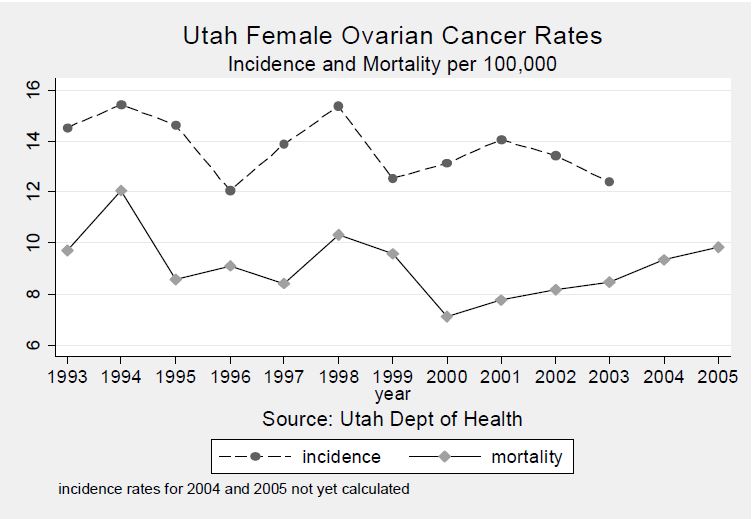Ovarian cancer is the eighth most common cancer in females in the United States, excluding non-melanoma skin cancer. It accounts for approximately 20,000 deaths per year nationally. In Utah, ovarian cancer rates are approximately the same as national rates. However, Utah’s death rates due to ovarian cancer were approximately 1% lower than the national mortality rate (8.2% vs. 9%) [1]. Lifetime risk of developing ovarian cancer is 1.5%. Upon diagnosis of ovarian cancer, less than half (about 45%) of women will survive longer than five years. However, if the ovarian cancer is detected early and has not spread to the surrounding tissue, 5-year survival rates are approximately 94%. Unfortunately, only about one in every five cases of ovarian cancer is detected at an early stage. Ovarian cancer incidence rates have decreased by about 0.7% per year since 1985 [2]. In Utah, ovarian cancer incidence and mortality rates have remained approximately stable from 1993 to 2005 [1].
Risk factors for ovarian cancer include family history, being over age 55, never having children, and menopausal hormone replacement therapy. Family history of ovarian cancer means having a mother, daughter, or sister with ovarian cancer. Links have been made between breast, uterine, colorectal, melanoma, thyroid, and pancreas cancers. Genetic mutations such as BRCA1 and BRCA2 are sometimes seen in women with ovarian cancer. White women have higher incidence rates and mortality rates of ovarian cancer compared to black women (See figure 2) [3].

A new study published in December 2006 showed a decrease of ovarian cancer in women who live in sunnier regions of the world. Researchers attributed this to vitamin D production which occurs in the body when exposed to sunlight. Researchers caution that people should not over expose themselves to sunlight as skin cancer is a far more common disease than ovarian cancer. Researchers state that people with fair skin need less than 15 minutes per day with less than 50% of their skin exposed for the maximum benefit. Studies are being done to assess whether vitamin D supplements are as effective as naturally occurring vitamin D made in the body [4].
There are no screening tests proven to be effective for early diagnosis of ovarian cancer. The signs and symptoms of ovarian cancer can be ambiguous and difficult to distinguish from benign conditions. Symptoms may include abdominal bloating, pelvic pain, vaginal bleeding, back or leg pain, and intestinal discomforts and abnormalities [3]. Annual gynecological exams by a physician are recommended because doctors are sometimes able to feel abnormalities in the ovaries and other reproductive organs. It is sometimes very difficult to detect abnormalities because the organs are deep within the pelvis and not easily palpable. Studies are being conducted by the National Cancer Institute to evaluate possible screening methods that may help to diagnose this cancer early and decrease mortality rates [2].
References
- Utah Department of Health. Available online at http://ibis.health.utah.gov. Accessed Oct 11, 2006.
- National Cancer Institute. Available online at http://www.cancer.gov. Accessed Dec 7, 2006.
- American Cancer Society. Available online at http://www.cancer.org. Accessed on Nov 20, 2006.
- American Journal of Preventive Medicine, December 2006. Abstract available online at Reuters Health at http://reutershealth.org. Accessed on Nov 20, 2006.


